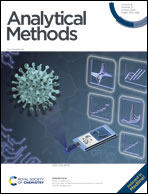Fe3+-induced luminescence quenching in carbon dots – mechanism unveiled†
Abstract
Carbon dot (CD)-based fluorimetric sensors have attracted immense attention for the detection of metal ions. Among the available works in this direction, more than 70% of the studies reported the detection of Fe3+ through luminescence quenching. Ferric ions are significant species from environmental and biological point of view. Excited-state electron transfer from carbon dots to ferric ions is suggested as the reason for the luminescence quenching. However, to date, no solid proof was provided to demonstrate this electron transfer process. Herein, N-doped blue luminescent carbon dots prepared via hydrothermal carbonization are used to demonstrate the exact mechanism operating in the above-mentioned detection strategy. The carbon dots possessed an average size of 4.9 nm, and exhibited good aqueous solubility as well as an excitation wavelength-dependent emission. Fe3+-mediated luminescence quenching was quantitatively achieved at the micromolar level, with a detection limit of 1.426 μM. The CD-mediated reduction of ferric ions is confirmed by spectral analysis. Fe3+-induced luminescence quenching was partially restored in the presence of ascorbic acid, enabling the sub-micromolar level monitoring of this analyte, with the lowest detection amount of 276 nM. Turnbull's blue method is adopted for confirming the reducing role of ascorbic acid, which eventually increased the luminescence of the system, evoking a turn-on response.



 Please wait while we load your content...
Please wait while we load your content...